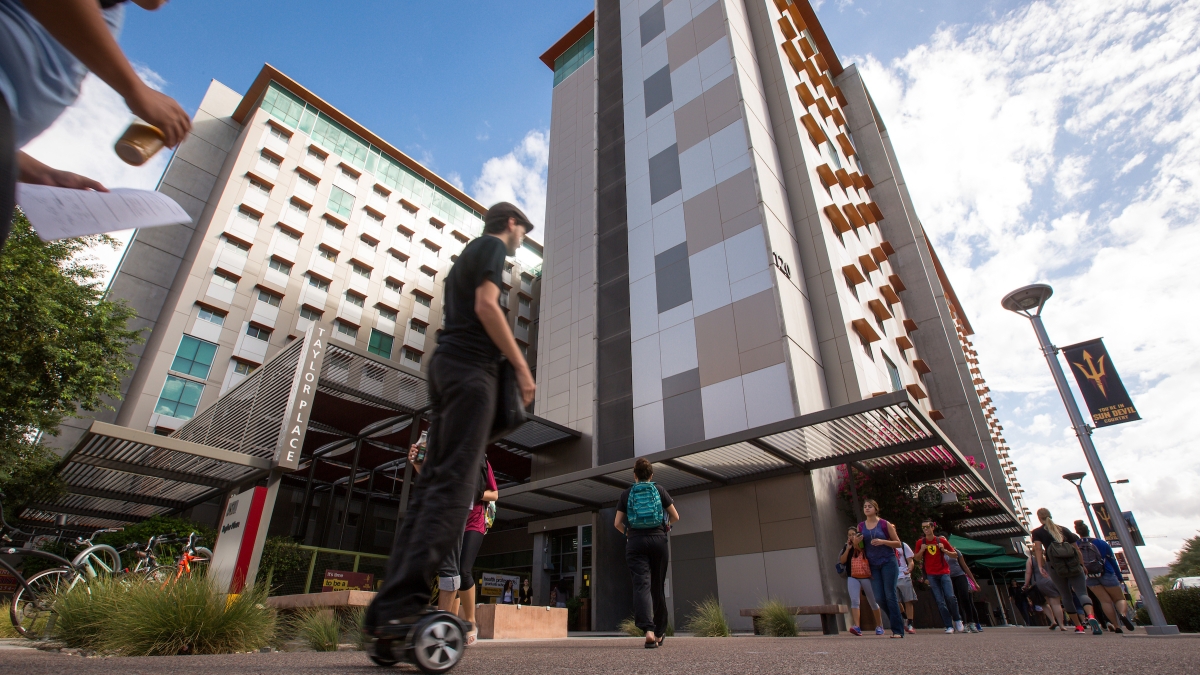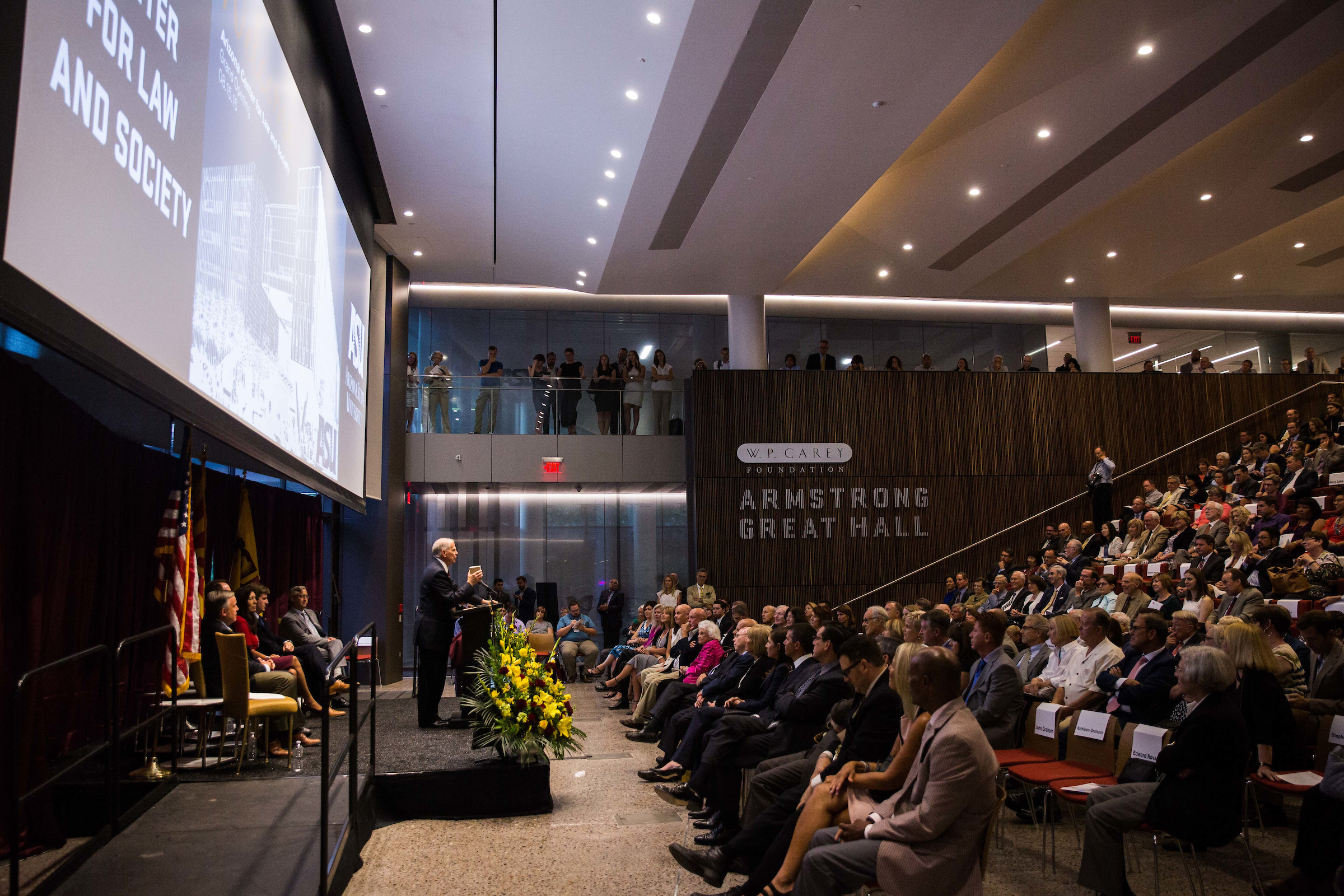It doesn’t take long to find a Phoenician who has a story or two about the years when downtown Phoenix pretty much went dark at 5:05 p.m. Sure, the arena and ballpark were there. But when the game or concert was over, most people hopped into their cars and hightailed out. Describing post-dinner food options as “limited” was generous. And nightlife? Ha.
Having worked in downtown for 20 years, Nicole Stanton, the Phoenix office managing partner for Quarles & Brady law firm, recalls when she brought in her own food for late nights at the office because the alternative was going hungry.
Today, a short evening stroll through these once-sleepy streets indicate those days are in the city’s rear-view mirror. The bevy of entertainment venues, cultural events, hospitality services and recreational experiences have since generated multiple reasons to linger.
And Arizona State University’s downtown campus — established in 2006 — is in the thick of the whirlwind resurgence that has made downtown Phoenix an enviable hot spot.
The timing of the arrival and progression of the downtown campus and surrounding community growth isn’t coincidence.
“Of all the things that have benefited downtown Phoenix, ASU having a presence in downtown has been the biggest game changer of all,” Stanton said.
It’s the result of a transformative partnership begun in 2005 between the city and ASU to develop a downtown campus. Less than a year later, Phoenix voters showed their support, approving a $223 million bond by a 2-1 margin, an unprecedented investment in higher education by a city.
Wellington “Duke” Reiter, executive director of the University City Exchange at ASU and senior adviser to President Michael M. Crow, lent his creative vision in the design of the Downtown Phoenix campus more than a decade ago.
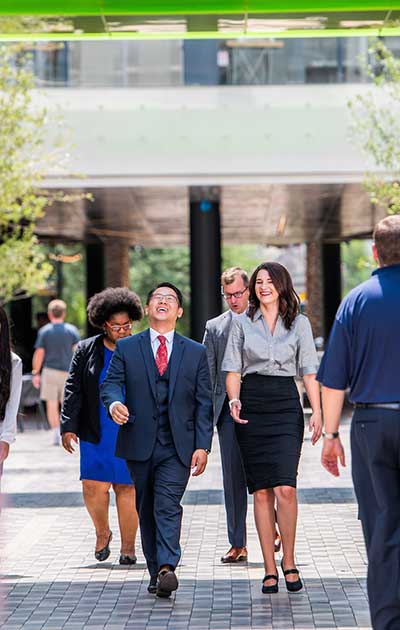
Photo by Jarrod Opperman/ASU
“At the time, we were communicating the mutual benefit for the city and university around such an idea,” Reiter said. “Having a relatively empty urban core in the fifth-largest city in the United States was not helpful in the attraction of new companies or research talent. Accordingly, both parties were motivated to fix the problem.
“Now that the campus is well established, the city is seeing more activity on the streets, increased retail and a renewed interest in the benefits of civic space — exactly what was anticipated. The park area around which many university and new private-sector buildings are gathered was purposefully designed to generate an enhanced relationship between residents, students, and employees in the area — a way for people to get to know their city and the university anew. Such urban amenities grow out of great partnerships,” he said.
The Valley Metro light rail line, hospitality services and corporate and independent businesses also play roles, changing the downtown landscape and culture with an influx of amenities that cater to locals’ and visitors’ needs.
According to a recent Downtown Phoenix Inc. report, this buzz is fueled by 7,000 residential units, 13,000 students, 400 tech and creative companies, and hundreds of hotel rooms that host business and leisure travelers. In combination with major sports, arts and cultural events, this development is a powerful factor in an estimated $9.7 billion annual value of total goods and services in the area.
The vision of a traditional campus that’s contained by geography to a few square blocks has diminished over the years. As buildings spread out to accommodate more programs moving downtown — most recently the Thunderbird School of Global Management — students and faculty have followed suit, becoming part of downtown community’s social fabric and creating age, profession and background diversity, explains Jim McPherson, downtown Phoenix advocate and executive director of Sustainable Communities Collaborative. Many have become true residents and see downtown as a spot to truly live, work and play alongside their nonuniversity neighbors.
“The campus design has evolved and become what the grass-roots community envisioned,” McPherson said.
Proximity and partnership with business
Downtown companies have also benefited from ASU’s presence. Sandra Day O’Connor College of Law students take on internships or other jobs at downtown law firms. Among them, Quarles & Brady, which invites top students to participate in its summer associate class.
For a decade, The Arizona Republic/azcentral has collaborated with the Walter Cronkite School of Journalism and Mass Communication on a breaking news multimedia reporting class that places student interns in virtually every department in the newsroom, from photo and digital production to features and sports. Each semester, about 14 students are assigned to the breaking news desk, where they get real-life experience speaking to police and fire personnel and witnesses, then generate stories for print, online and even Facebook Live content.
“What we get are additional young journalists who can be on the scene in many more places than we could without them,” said Kathy Tulumello, news director for Arizona Republic/azcentral.
Building art audiences
From professional opportunities to a rich cultural life, downtown has evolved in skyline-changing leaps and fine-grain growths, too, especially in Phoenix’s creative community downtown.
Roosevelt Row started as an informal idea among many artists who had relocated into the area. As a recent alum of the ASU School of Art, Greg Esser was working with others from his ASU studio to build projects on Roosevelt including galleries like Eye Lounge and 515 Gallery. He credits the evolution of downtown Phoenix in part to the high concentration of artists, one aspect of “making” a destination.
“One of the driving changes in the perception of downtown was by the artists and the building of First Fridays over the years. It created a catalytic impact that supported businesses relying on that First Friday audience,” said Esser.
Now as a leader in the Herberger Institute for Design and the Arts, Esser is supporting expansion of ASU’s art and design efforts downtown. His work is now focused on the next wave of artists, collaborating with the school’s leadership and the more than 300 graduate students at Grant Street Studios on the next chapter of growth.
With a law school that offers affordable legal advice, several colleges serving health and well-being needs, hundreds of artists building creative works and an urban campus that is inviting to all, the university has bonded with the core of the nation’s fifth-largest city.
“ASU’s presence downtown has brought a vibrancy, a livelihood. People live downtown now, they don’t just work here,” Stanton said. “The benefit of that and the transformation it had on downtown cannot be understated.”
Timeline: Catalyzing moments in a downtown’s evolution
Many elements make the center of Phoenix the vibrant place it is today. From campus development to community partnerships, many investments and events have come together to bring the Downtown Phoenix campus to life. A few highlights:
1989
Artlink connects art spaces
Artlink forms and organizes Art Detour, a multi-day, self-guided tour of galleries, studios and businesses in and around downtown.
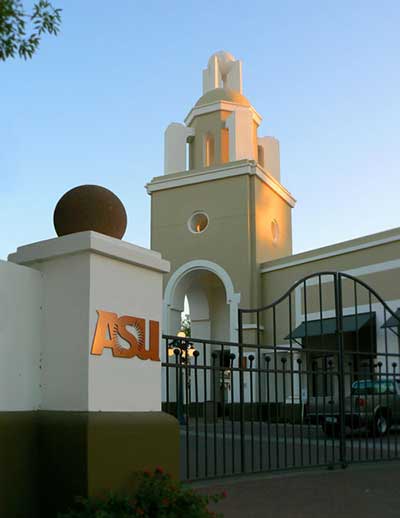
ASU Mercado.
1990
ASU Downtown Center at the Mercado
Day, evening and weekend courses, degrees and professional-development programs including urban design, policy and community service are introduced. Programs bring faculty, students, local government, state agencies and other organizations together to work on local and statewide challenges.
1990–96
New artist enclaves emerge
Due to construction of what are now Chase Field and Talking Stick Resort Arena, many artists in the warehouse district are displaced, leading them to purchase properties in new areas, including Roosevelt Row and Grand Avenue. USA Today later names Roosevelt Row one of the 10 Best City Arts Districts in America.
1994
First Fridays
Artlink and other downtown Phoenix artists start to officially promote this monthly art walk, which has grown to become one of the largest in the U.S. With many venues open free to the public each month, First Fridays succeeds in bringing people back to downtown Phoenix. The event currently attracts from 14,000 to 20,000 visitors monthly and continues to grow.
2001
Downtown Phoenix Ambassadors
The Downtown Phoenix Partnership starts a safety program that would evolve into a hospitality service with specially trained downtown Phoenix customer-service ambassadors, who help with events and navigation of downtown.
2005
Phoenix Urban Research Lab
Known as PURL, this working research center opens and fosters the idea for the downtown campus. Through a combination of supported research, coordinated coursework and public programming, PURL assembles different academic units within the university and the public sphere. PURL launches Phoenix Urban Design Week, a series of highly anticipated annual events still active today.
2005
ASU, City of Phoenix partner on campus development
ASU and the City of Phoenix announce a transformative partnership for the development of the ASU Downtown Phoenix campus, which is approved by a 2-to-1 margin by the city’s voters one year later.
2005
Phoenix Public Market’s open-air market debuts
Located at what is now the Phoenix Public Market Café parking lot, this destination spot is composed of more than 80 independent vendors selling wares, including local produce and other goods every Saturday.
2006
The new campus
The Downtown Phoenix campus officially opens with 2,766 students and three colleges — College of Nursing, College of Public Programs and University College — housed in two office buildings speedily remodeled for classroom use. Students move into a refurbished 1955 Ramada Inn, which serves as a temporary residence hall for the campus’s first two years. Later in the year, the School of Social Work moves to the downtown campus, becoming part of the College of Public Programs. Two years later, the School of Criminology and Criminal Justice relocates from the West campus to join the college. Today the campus offers programs across eight degree-granting colleges and schools.
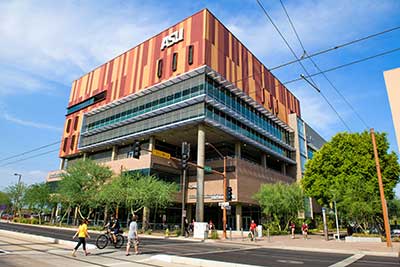
The Walter Cronkite School of Journalism and Mass Communication. Photo by Jarod Opperman/ASU
2007
Groundbreaking for Cronkite School
Former CBS News anchor Walter Cronkite breaks ground on what will become the campus’s first newly constructed building, designed to house the Walter Cronkite School of Journalism and Mass Communication and Arizona PBS. In 2008, the fourth college of the campus opens its new home, a state-of-the-art digital communications complex.
2007
A biomedical collaboration
The Arizona Biomedical Collaborative Building opens as part of the Phoenix Biomedical Campus, a medical and bioscience campus. The LEED-certified building houses bioinformatic programs for ASU and research programs for the University of Arizona.
2008
Downtown living
Students move into Taylor Place, a newly built 13-story residential complex with a rooftop terrace, mountain vistas and city views. A second tower opens the following year.
2008
Phoenix Convention Center is revamped
A $600 million demolition and expansion is completed, creating a new and improved venue to accommodate national conventions and crowd-drawing events like Phoenix Fan Fusion, Comicon and NFL Super Bowl fan activities.
2008
CityScape construction begins
Construction begins on a 1.2 million-square-foot urban multi-use development, to be used as office buildings, residential units, a hotel, retail shops, restaurants, bars and entertainment venues. It’s also the site of an outdoor ice rink each winter.
2008
Light rail opens
Valley Metro light rail service begins, linking the Downtown Phoenix campus to Tempe.
2009
ASU Preparatory Academy Phoenix
The academy opens downtown. Today it includes preschool, elementary, middle and high schools, and its curriculum helps students develop critical thinking and learning skills to prepare them for college.
2009
Civic Space Park
City officials dedicate Civic Space Park, a 2.7-acre grassy oasis that replaces abandoned storefronts and empty lots. The A.E. England Building, an abandoned 1926 auto dealership on the city’s historic registry, is dedicated after a major renovation, and serves as an anchor in the park. It is used daily for classes, public meetings, art displays and special events.
2009
New nursing building
The Downtown Phoenix campus dedicates its second new academic building, an 84,000-square-foot building, part of the College of Nursing and Health Innovation.
2011
Sustainability focus
The Downtown Phoenix campus dedicates its first solar power grid on the roof of the Cronkite School. Sustainability is a key feature of the campus, which has seven LEED-certified buildings.
2011
Crescent Ballroom opens
This music venue, bar and restaurant hot spot opens and quickly establishes itself as a premiere Valley music destination. It is the first of several downtown venues by promoter Charlie Levy; his second, the concert space the Van Buren, opens in 2017.
2012
Fifth college based downtown
The newly established College of Health Solutions opens on the Downtown Phoenix campus.
2013
Feast on the Street
This half-mile-long dining table set up on First Street turns the stretch into a pedestrian promenade in celebration of food and art in one of the largest outdoor events downtown to date, galvanizing art, food and neighborhood community ties. The feast is a free public event and community project initiated by the ASU Art Museum and the Desert Initiative, Roosevelt Row Community Development Corp. and artists Clare Patey and Matt Moore.
2013
Adaptive reuse
The new Student Center opens in the historic U.S. Post Office building on Central Avenue adjacent to Civic Space Park.
2013
McDowell Mountain Music Festival
Originally held in Scottsdale, the festival now known as M3M moves to Margaret T. Hance Park. This 100-percent nonprofit music festival has attracted visitors with major bands. The precedent set by strong attendance, Viva PHX debuts soon after, bringing a live music extravaganza hostsing 50 bands on 13 stages across downtown.
2013
Fitness center
Students celebrate the grand opening of the new Sun Devil Fitness Center, a 73,800-square-foot health and recreational complex featuring extensive cardio and weight equipment and a rooftop pool overlooking the campus.
2013
$275 million
worth of goods and services created by ASU’s 2013 nonpayroll spending around the downtown campus. These goods and services are supplied by Phoenix businesses. More stats from that year: 2,100 jobs, $101 million in labor income, $168 million in gross product directly created by ASU’s spending downtown.
2014
Grant Street Studios opens
This venue for the ASU School of Art in the Herberger Institute for Design and the Arts moves several of its graduate studio programs to the Phoenix Warehouse District.
2014
GRID Bike Share launches
The first ever city-shared bike system launches in the urban core of Phoenix with bikes available for rent via a mobile app.
2014
Beus Center for Law and Society
Construction begins on the $129 million, 260,000-square-foot complex that will become the new home for the Sandra Day O’Connor College of Law in 2016. The building space is designed to be inviting, engaging and accessible to everyone who is interested in learning about the law, its effect on our daily lives, and the many services and resources available through ASU and other BCLS partners.
2016
ASU’s Collaboratory on Central in the Westward Ho
The community service clinic combining health and social outreach opens inside the historic Westward Ho hotel. This clinic includes office and event space on the first floor of the landmark 1928 hotel. It houses students studying social work, nursing, health monitoring and counseling, and the ASU Center for Applied Behavioral Health Policy.
2017
Growing numbers
The downtown campus reaches 11,465 students and 644 faculty members.
2018
Phoenix backs expansion for Thunderbird
The Phoenix City Council approves a $13.5 million investment for a new downtown building to house the Thunderbird School of Global Management.
Leo Beus addresses guests during the grand opening of the Beus Center for Law and Society on Aug. 15, 2016. Photo by Deanna Dent/ASU Now
ASU’s growth to many locations
1885: ASU Tempe campus
The Territorial Normal School is created to train teachers and teach agriculture and mechanical arts. Today, ASU offers hundreds of majors that engage undergraduates and graduates in multidisciplinary research and exploration. The Novus Innovation Corridor will integrate mixed-use urban development with enhanced collegiate athletic venues.
1984: ASU West campus
Established by the Arizona Legislature as the university’s second campus, ASU West is located on the western edge of Phoenix. Today the campus offers more than 50 undergraduate and graduate degrees across six colleges. The Gary K. Herberger Young Scholars Academy on the campus is a learning environment for highly gifted students in grades 7-12.
1996: ASU Polytechnic campus
Founded as ASU East on the former Williams Air Force Base, this campus offers degrees in interdisciplinary sciences, engineering, management, aviation, technology and education. Industry partnerships provide learning opportunities within advanced lab spaces. ASU Prep preschool, STEM Academy for K-8 and a STEM high school are on this campus.
2002: Mayo Clinic and Arizona State University Alliance for Health Care
Together, Mayo Clinic, the recognized world leader in patient care, education and research, and ASU, the nation’s most innovative university, are bringing the brightest minds together to accelerate cutting-edge research discoveries, improve patient care through health care innovation and transform medical education to enhance health outcomes.
2008: SkySong Innovation Center
The center is responsible for more than 100 spinoff companies that have collectively raised more than $600 million in venture capital. It is also home of the ASU Online/Starbucks degree program with ASU’s EdPlus team.
2012: ASU at Lake Havasu
This collaboration between the Lake Havasu Foundation and ASU brings the university’s innovative approach to higher education to a location unserved by the state university system. Students at Havasu now choose from more than 20 four-year undergraduate degree programs.
2018: ASU in Downtown Mesa
The city council approves a partnership with ASU for a campus in the center of Arizona’s second-largest city. ASU agrees to bring at least 750 students and 40 faculty members, with at least 25 scholarships earmarked for students within Mesa city limits.
Written by By Georgann Yara. Top photo of Taylor Place by Charlie Leight/ASU Now. This story originally appeared in the fall issue of ASU Thrive magazine.
More Arts, humanities and education

ASU professor's project helps students learn complex topics
One of Arizona State University’s top professors is using her signature research project to improve how college students learn science, technology, engineering, math and medicine.Micki Chi, who is a…

Award-winning playwright shares her scriptwriting process with ASU students
Actions speak louder than words. That’s why award-winning playwright Y York is workshopping her latest play, "Becoming Awesome," with actors at Arizona State University this week. “I want…

Exceeding great expectations in downtown Mesa
Anyone visiting downtown Mesa over the past couple of years has a lot to rave about: The bevy of restaurants, unique local shops, entertainment venues and inviting spaces that beg for attention from…


